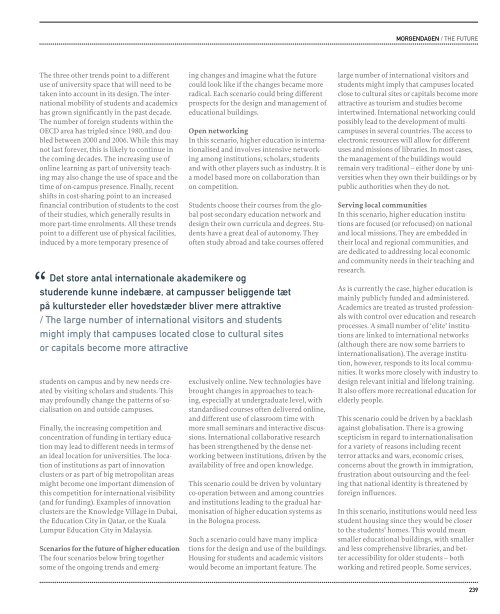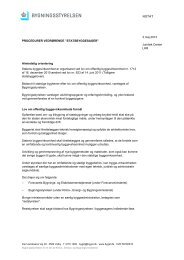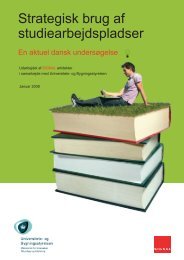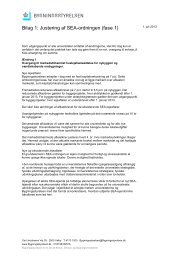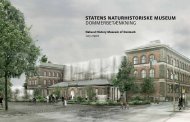Campus og studiemiljø - Bygningsstyrelsen
Campus og studiemiljø - Bygningsstyrelsen
Campus og studiemiljø - Bygningsstyrelsen
Create successful ePaper yourself
Turn your PDF publications into a flip-book with our unique Google optimized e-Paper software.
The three other trends point to a different<br />
use of university space that will need to be<br />
taken into account in its design. The international<br />
mobility of students and academics<br />
has grown significantly in the past decade.<br />
The number of foreign students within the<br />
OECD area has tripled since 1980, and doubled<br />
between 2000 and 2006. While this may<br />
not last forever, this is likely to continue in<br />
the coming decades. The increasing use of<br />
online learning as part of university teaching<br />
may also change the use of space and the<br />
time of on-campus presence. Finally, recent<br />
shifts in cost-sharing point to an increased<br />
financial contribution of students to the cost<br />
of their studies, which generally results in<br />
more part-time enrolments. All these trends<br />
point to a different use of physical facilities,<br />
induced by a more temporary presence of<br />
students on campus and by new needs created<br />
by visiting scholars and students. This<br />
may profoundly change the patterns of socialisation<br />
on and outside campuses.<br />
Finally, the increasing competition and<br />
concentration of funding in tertiary education<br />
may lead to different needs in terms of<br />
an ideal location for universities. The location<br />
of institutions as part of innovation<br />
clusters or as part of big metropolitan areas<br />
might become one important dimension of<br />
this competition for international visibility<br />
(and for funding). Examples of innovation<br />
clusters are the Knowledge Village in Dubai,<br />
the Education City in Qatar, or the Kuala<br />
Lumpur Education City in Malaysia.<br />
scenarios for the future of higher education<br />
The four scenarios below bring t<strong>og</strong>ether<br />
some of the ongoing trends and emerg-<br />
ing changes and imagine what the future<br />
could look like if the changes became more<br />
radical. Each scenario could bring different<br />
prospects for the design and management of<br />
educational buildings.<br />
open networking<br />
In this scenario, higher education is internationalised<br />
and involves intensive networking<br />
among institutions, scholars, students<br />
and with other players such as industry. It is<br />
a model based more on collaboration than<br />
on competition.<br />
Students choose their courses from the global<br />
post-secondary education network and<br />
design their own curricula and degrees. Students<br />
have a great deal of autonomy. They<br />
often study abroad and take courses offered<br />
“<br />
det store antal internationale akademikere <strong>og</strong><br />
studerende kunne indebære, at campusser beliggende tæt<br />
på kultursteder eller hovedstæder bliver mere attraktive<br />
/ the large number of international visitors and students<br />
might imply that campuses located close to cultural sites<br />
or capitals become more attractive<br />
exclusively online. New technol<strong>og</strong>ies have<br />
brought changes in approaches to teaching,<br />
especially at undergraduate level, with<br />
standardised courses often delivered online,<br />
and different use of classroom time with<br />
more small seminars and interactive discussions.<br />
International collaborative research<br />
has been strengthened by the dense networking<br />
between institutions, driven by the<br />
availability of free and open knowledge.<br />
This scenario could be driven by voluntary<br />
co-operation between and among countries<br />
and institutions leading to the gradual harmonisation<br />
of higher education systems as<br />
in the Bol<strong>og</strong>na process.<br />
Such a scenario could have many implications<br />
for the design and use of the buildings.<br />
Housing for students and academic visitors<br />
would become an important feature. The<br />
morgendagen / tHe Future<br />
large number of international visitors and<br />
students might imply that campuses located<br />
close to cultural sites or capitals become more<br />
attractive as tourism and studies become<br />
intertwined. International networking could<br />
possibly lead to the development of multicampuses<br />
in several countries. The access to<br />
electronic resources will allow for different<br />
uses and missions of libraries. In most cases,<br />
the management of the buildings would<br />
remain very traditional – either done by universities<br />
when they own their buildings or by<br />
public authorities when they do not.<br />
serving local communities<br />
In this scenario, higher education institutions<br />
are focused (or refocused) on national<br />
and local missions. They are embedded in<br />
their local and regional communities, and<br />
are dedicated to addressing local economic<br />
and community needs in their teaching and<br />
research.<br />
As is currently the case, higher education is<br />
mainly publicly funded and administered.<br />
Academics are treated as trusted professionals<br />
with control over education and research<br />
processes. A small number of ‘elite’ institutions<br />
are linked to international networks<br />
(although there are now some barriers to<br />
internationalisation). The average institution,<br />
however, responds to its local communities.<br />
It works more closely with industry to<br />
design relevant initial and lifelong training.<br />
It also offers more recreational education for<br />
elderly people.<br />
This scenario could be driven by a backlash<br />
against globalisation. There is a growing<br />
scepticism in regard to internationalisation<br />
for a variety of reasons including recent<br />
terror attacks and wars, economic crises,<br />
concerns about the growth in immigration,<br />
frustration about outsourcing and the feeling<br />
that national identity is threatened by<br />
foreign influences.<br />
In this scenario, institutions would need less<br />
student housing since they would be closer<br />
to the students’ homes. This would mean<br />
smaller educational buildings, with smaller<br />
and less comprehensive libraries, and better<br />
accessibility for older students – both<br />
working and retired people. Some services,<br />
239


